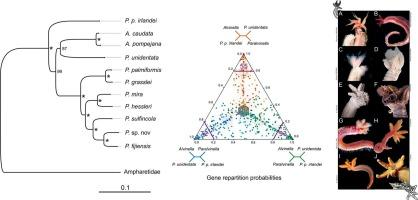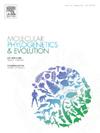Alvinellidae (Annelida: Polychaeta) 深度进化的一步:基于转录组的系统进化比较方法。
IF 3.6
1区 生物学
Q2 BIOCHEMISTRY & MOLECULAR BIOLOGY
引用次数: 0
摘要
Alvinellidae 是太平洋和印度洋深海热液喷口特有的蠕虫科。这些无环蠕虫是热液虫科(Ampharetidae)的姊妹科,占据着广泛的热栖息地。该科包括迄今为止所描述的最耐高温的海洋动物,如庞贝虫 Alvinella pompejana,以及生活在更低温度下的其他物种,如 Paralvinella grasslei 或 Paralvinella pandorae。该科的系统发育尚未得到广泛研究。然而,这是一个复杂的例子,分子系统发育给出了相互矛盾的结果,特别是关于 Paralvinella 属的单系或多系性质。我们利用目前可从 RNAseq 数据集获得的最佳分子数据,对该科的系统发生进行了全面研究,为目前已描述或正在描述的 14 个物种中的 11 个物种找到了数百个同源转录本。我们使用一系列两栖类和小脑类外群,比较了两种最流行的系统发生推断模型(使用最大似然法的基因串联或基于基因树的聚合模型)得出的结果。我们的研究表明,总体系统发生信号倾向于 Paralvinella 属的旁系假说,P. pandorae 是其他 Alvinellidae 的姊妹种。然而,大量的基因树也支持替代树的假说,在这些替代树中,Desbruyères 和 Laubier 最初提出的 Paralvinella 属的单系是有效的,P. pandorae 和 Paralvinella unidentata 是姐妹种。根据分子年代测定,阿尔文贝科的辐射非常迅速,发生在 8000 万年前到 1.1 亿年前的短时间内。这反映在基因组尺度上,不同系统发育假说之间的基因树相等分离,表明阿尔文鱼科第一世系之间的不完全世系分类率很高,而且可能存在基因转移。尽管不同的基因组区域在阿尔文贝类辐射的早期阶段似乎有不同的系统发育故事,但我们的研究支持这样一种观点,即两个 P. pandorae 物种可归入一个单独的属(可能是 Nautalvinella 属),而 Desbruyères 和 Laubier 所定义的 Miralvinella 亚属已不再有效。本文章由计算机程序翻译,如有差异,请以英文原文为准。

A step in the deep evolution of Alvinellidae (Annelida: Polychaeta): A phylogenomic comparative approach based on transcriptomes
The Alvinellidae are a family of worms that are endemic to deep-sea hydrothermal vents in the Pacific and Indian Oceans. These annelid worms, a sister group to the Ampharetidae, occupy a wide range of thermal habitats. The family includes the most thermotolerant marine animals described to date such as the Pompeii worm Alvinella pompejana, and other species living at much lower temperatures such as Paralvinella grasslei or Paralvinella pandorae. The phylogeny of this family has not been studied extensively. It is, however, a complex case where molecular phylogenies have given conflicting results, especially concerning the monophyletic or polyphyletic nature of the genus Paralvinella.
We carried out a comprehensive study of the phylogeny of this family using the best molecular data currently available from RNAseq datasets, leading to several hundred orthologous transcripts for 11 of the 14 species currently described or in description. The results obtained by the two most popular phylogenetic inference models (using either gene concatenation with maximum likelihood, or a coalescent-based model from gene trees) were compared using a series of ampharetid and terebellid outgroups.
Our study shows that the global phylogenetic signal favors the hypothesis of paraphyly for the Paralvinella genus, with P. pandorae being sister species of the other Alvinellidae.
However, a high number of gene trees also supports the hypothesis of alternative trees in which the monophyly of the Paralvinella genus, as initially proposed by Desbruyères and Laubier, is valid with the species P. pandorae and Paralvinella unidentata being sister species. According to molecular dating, the radiation of the Alvinellidae was rapid and took place in a short period of time between 80 and 110 million years ago. This is reflected at the genomic scale by gene trees equally separated between different phylogenetic hypothesis, showing high rates of incomplete lineage sorting between the first lineages of the Alvinellidae and probable gene transfers. Although different genomic regions seem to have different phylogenetic stories in the early step of the alvinellid radiation, our study supports the view that the two P. pandorae species can be grouped into a separate genus (possibly Nautalvinella) and that the Miralvinella subgenus, defined by Desbruyères and Laubier, is not valid anymore.
求助全文
通过发布文献求助,成功后即可免费获取论文全文。
去求助
来源期刊
CiteScore
7.50
自引率
7.30%
发文量
249
审稿时长
7.5 months
期刊介绍:
Molecular Phylogenetics and Evolution is dedicated to bringing Darwin''s dream within grasp - to "have fairly true genealogical trees of each great kingdom of Nature." The journal provides a forum for molecular studies that advance our understanding of phylogeny and evolution, further the development of phylogenetically more accurate taxonomic classifications, and ultimately bring a unified classification for all the ramifying lines of life. Phylogeographic studies will be considered for publication if they offer EXCEPTIONAL theoretical or empirical advances.

 求助内容:
求助内容: 应助结果提醒方式:
应助结果提醒方式:


